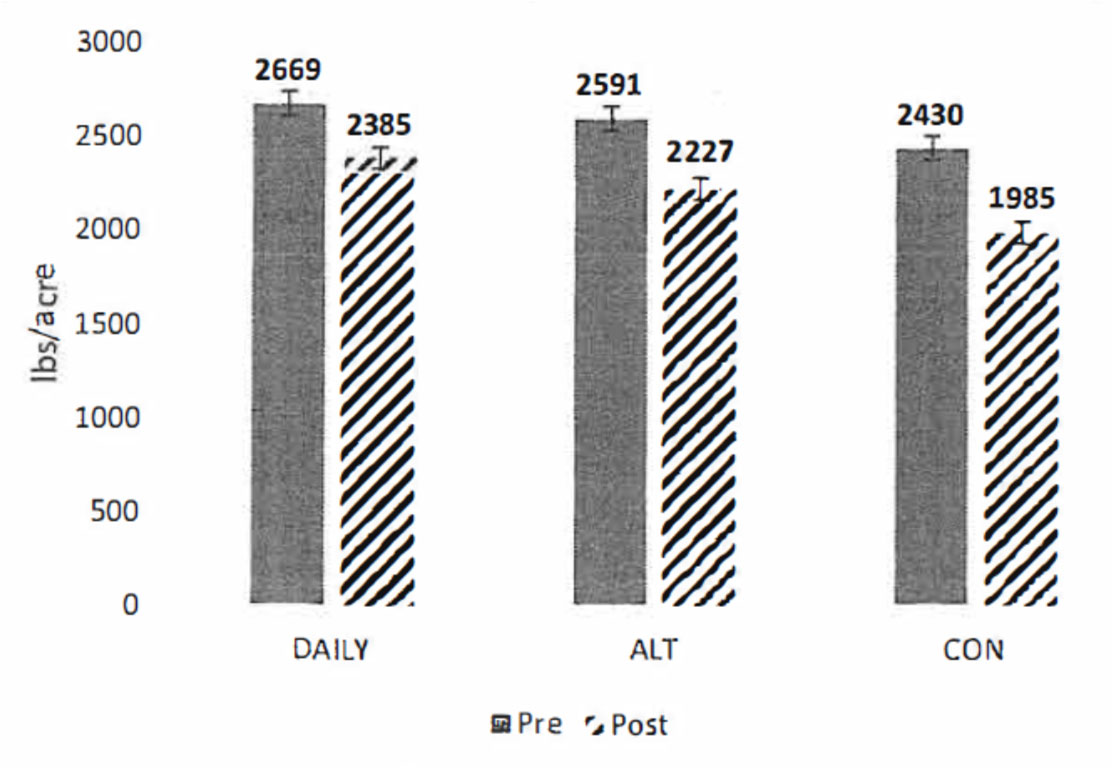Strategies for DDGS Supplementation Frequency to Grazing Yearling Steers
Monday, April 1, 2024
Reducing frequency of supplementation can reduce labor costs in backgrounding cattle operations. A possible supplement choice for grazing cattle is dried distillers grains plus solubles (DDGS). However, research from the University of Nebraska evaluating the frequency on DDGS supplementation provided inconsistent results. Research from 2003 showed that infrequent supplementation of DDGS reduced steer average daily gain (ADG) by 10%.1 Whereas, research from 2022 observed no differences in animal performance with daily vs. infrequent supplementation of DDGS.2 Thus, additional Nebraska research evaluated the effects of daily and three times a week supplementation of DDGS on yearling steer performance grazing smooth bromegrass pastures from May to August.3
In this study, 144 crossbred yearling steers (698 lb) were randomly assigned to one of twenty-four paddocks in a randomized generalized block design with three treatments. The blocking factor was pasture location. There were four pasture blocks, each containing six paddocks and two treatment replicates. The three treatments included a control treatment (CON) receiving no supplement, a daily treatment (DAILY) which received 5.6 lb of dry matter (DM) per steer of DDGS seven days a week, and a three times per week treatment (ALT) which received 13.0 lb of DM of DDGS on Monday, Wednesday, and Friday. The DAILY treatment was fed supplement at 0.8% of initial body weight (BW) per day and ALT was fed supplement at 1.86% of initial BW. Both supplement groups received the same amount of supplement over a week. Supplement was delivered into a feed bunk to minimize waste. Paddocks were divided equally into three strips and rotationally grazed. The steers grazed 97 days. Each treatment group rotated through three 2.00-acre strips per pasture. Pre-graze and post-graze biomass were measured in duplicate at ground level from each paddock at each rotation. Pre-graze biomass samples were used to determine forage availability.
The results of this study are reported in Table 1. The control calves gained 1.86 Ib/day. Both DDGS treatments increased average daily gain (ADG) compared to the controls (P < 0.01), with DAILY supplementation gaining 2.75 lb/day and ALT gaining 2.45 Ib/day. However, ADG was decreased (P < 0.01) with ALT compared to DAILY supplementation. The differences in ADG were reflected in similar differences in ending BW.
Item |
DAILY |
Treatment1 ALT |
CONTROL |
P-value |
|---|---|---|---|---|
| Initial BW, lb | 698 | 699 | 700 | 0.96 |
| Ending BW, lb | 961a | 933b | 878c | <0.01 |
| ADG, lb | 2.75a | 2.45b | 1.86c | <0.01 |
1Treatments included daily (DAILY) DDGS supplementation fed at 5.6 lb DM per steer, alternate (ALT) DDGS supplementation fed 3x per week at 13.0 lb DM per steer, and a non-supplemented control (CONTROL).
a,b,cMeans within a row with different superscripts differ (P < 0.05). Adapted from Vanderhoff et al., 2024.
The pre-biomass of controls was lower when compared to DAILY (P < 0.01; Figure 1). Similarly, post-biomass was reduced in control treatments compared to the supplemented treatments (P < 0.01). These data suggest that the control calves may have consumed more forage than the supplemented treatments.
Figure 1. Pre and post graze biomass availability from three DOGS supplementation strategies of steers grazing Smooth Bromegrass paddocks.
These researchers concluded that “providing supplemental DDGS increases ADG compared to non-supplemented steers, while infrequent supplementation reduces gain compared to daily supplementation by approximately 10%”. They also noted that “forage intake of supplemented steers is likely reduced compared to non-supplemented steers which may allow producers to increase the stocking rate of a pasture system. The economic and logistical viability of daily supplementation depends on the cost and availability of labor required to provide the supplement.”
1Loy T., T. Klopfenstein, G. Erickson, and C. Macken. 2003. Value of dry distillers grains in high-forage diets and effect of supplementation frequency. Nebraska Beef Cattle Reports, pp 8-10.
2Linder, H. F., Z. E. Carlson, M. E. Drewnoski, and J. C. MacDonald. 2022. Interaction of urea with frequency and amount of distillers grains supplementation for growing steers. Nebraska Beef Cattle Report MP115:26-27.
3Vanderhoff, S. T., R. L. Sjostrand, M. M. Norman, I. F. Vicci, J. C. MacDonald, and M. E. Drewnoski. 2024. Strategies for DDGS supplementation frequency to grazing yearling steers. Nebraska Beef Cattle Report MP118:35-36.

